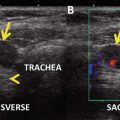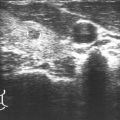© Springer International Publishing Switzerland 2016
David S. Cooper and Cosimo Durante (eds.)Thyroid Cancer10.1007/978-3-319-22401-5_55. Completion Thyroidectomy in a Patient with Low-Risk Papillary Cancer
(1)
Division of Endocrinology, Diabetes, and Metabolism, The Johns Hopkins University School of Medicine, 1830 E. Monument St., Suite 333, Baltimore, MD 21287, USA
Keywords
completion thyroidectomyintederminate thyroid nodulepapillary thyroid cancerThe Case
The patient is a 25-year-old woman who was found to have a 2 cm right thyroid nodule on routine physical examination by her gynecologist. Thyroid ultrasound revealed a 2 cm nodule that was mildly hypoechoic with a sonolucent rim and internal vascularity. The contralateral lobe looked normal sonographically. FNA showed a “follicular lesion of undetermined significance” (Bethesda class III). After discussing the pros and cons of lobectomy versus total thyroidectomy, she underwent a right hemithyroidectomy. The final pathology revealed a 1.5 cm unifocal follicular variant papillary cancer with no extrathyroidal extension, negative margins, and no evidence of venous or lymphatic invasion. No lymph nodes were removed at the time of surgery. Her surgeon recommended a completion thyroidectomy in the near future, and she comes to discuss whether this is really necessary.
Assessment and Literature Review
Many patients undergo thyroid lobectomy because of indeterminate thyroid nodules. Anywhere from 15 to 40 % of these patients prove to have thyroid cancer [1], and the question of completion thyroidectomy is often raised. But, it remains unsettled whether completion thyroidectomy is necessary in all patients who are found to have low-risk papillary cancer in the operated lobe. Theoretically, there are two reasons to consider completion thyroidectomy: the contralateral lobe may harbor occult disease which could be the source of recurrence in the future, and in order to enable the patient to receive radioiodine ablative therapy, a total thyroidectomy is generally required. A third, less compelling reason may be that follow-up with thyroglobulin measurements may be less ambiguous in patients who have been thyroidectomized.
With regard to the first potential indication, numerous studies have shown that there is 30–80 % prevalence of contralateral thyroid cancer [2]. This is typically micropapillary thyroid cancer (foci <10 mm), with a higher frequency in patients who have multifocal disease in the removed lobe and possibly also in patients who are older or who have larger primary tumors (e.g., [2]). However, despite this high frequency of residual malignant foci, the clinical recurrence rates in the contralateral lobe are very low, in the 1–4 % range, consistent with the concept that these small thyroid cancer foci are relatively innocuous [3]. This observation is similar to what is known about small subclinical central lymph node metastases that are found after a prophylactic central neck dissection, which have a similar prevalence (30–80 %), but which also have a very low rate of clinical recurrence, in the 1–2 % range [4].
In the 2009 American Thyroid Association guidelines for the management of thyroid cancer, completion thyroidectomy was recommended for patients with primary tumors ≥1 cm in diameter [5]. This recommendation was based on two studies. The first was an older study by Hay et al. showing that while completion thyroidectomy did not improve cause-specific mortality, it did decrease the risk of locoregional recurrence [19 % nodal metastasis rate at 20 years for lobectomy versus a 6 % recurrence rate for “bilateral lobar resection” (P = 0.0001)] [6]. However, it was the large study by Bilimoria et al. [7] which used data from the National Cancer Data Base that included over 52,000 patients that was the main driver of the 2009 ATA recommendation. These authors found that recurrence rates were higher [hazard ratio 1.24 (95 % confidence interval 1.01–1.54, P = 0.04)] and overall survival was lower [hazard ratio 1.49 (95 % CI 1.02–2.17, P = 0.04)] when patients underwent less than a total thyroidectomy for tumors 1–2 cm in diameter, compared to no difference in outcomes in patients with tumors <1 cm in diameter. However, this study has been faulted because only “overall survival” and not “disease-specific survival” was reported [8]. Since the mortality rates for differential thyroid cancer are extremely low, disease-specific survival is a much more important indicator of treatment efficacy. Also, information on extrathyroidal extension and completeness of tumor removal was not available, and if lobectomy was performed in some patients because of other comorbid conditions, or because of a compromised contralateral recurrent nerve, then these factors may have biased the results. Furthermore, the paper reported that 18 % of patients who underwent lobectomy received radioiodine therapy postoperatively, suggesting the possibility that some of the patients were misclassified and actually had undergone completion thyroidectomy.
In addition to the study cited above [3], there have now been other studies also showing no advantage of total thyroidectomy over lobectomy. For example, in a paper using data extracted from the Surveillance, Epidemiology, and End Results (SEER) database involving almost 23,000 patients, of whom almost 6000 patients underwent lobectomy, there were no differences in disease-specific survival between patients who underwent total thyroidectomy versus lobectomy in multivariate analyses, and this was true for all tumor sizes up to 4 cm [9]. Similarly, in another study from Memorial Sloan Kettering Cancer Center involving a retrospective analysis of almost 900 patients with low-risk papillary thyroid cancer followed for an average of 10 years, there were no differences in disease-specific survival and in recurrence-free survival between patients who received a total thyroidectomy versus lobectomy (10-year disease-specific survival was 100 % for the lobectomy group versus 98.5 % for the total thyroidectomy group) [10]. Similarly, local recurrence rates were 0 % for both groups, and regional recurrence rates were 0 % versus 0.8 % in the lobectomy versus total thyroidectomy groups, respectively. In multivariate analyses, only age >45 years and male gender were predictors of worse outcome, whereas the T stage and type of surgery were not predictive [10]. Thus, data showing better outcomes after total thyroidectomy (or completion thyroidectomy) have been questioned in more recent studies. And while completion thyroidectomy does not have greater morbidity than an initial total thyroidectomy, the morbidity of a total thyroidectomy is higher than that of a lobectomy even in the hands of high-volume surgeons [11].
Stay updated, free articles. Join our Telegram channel

Full access? Get Clinical Tree






